
1998 – 2023
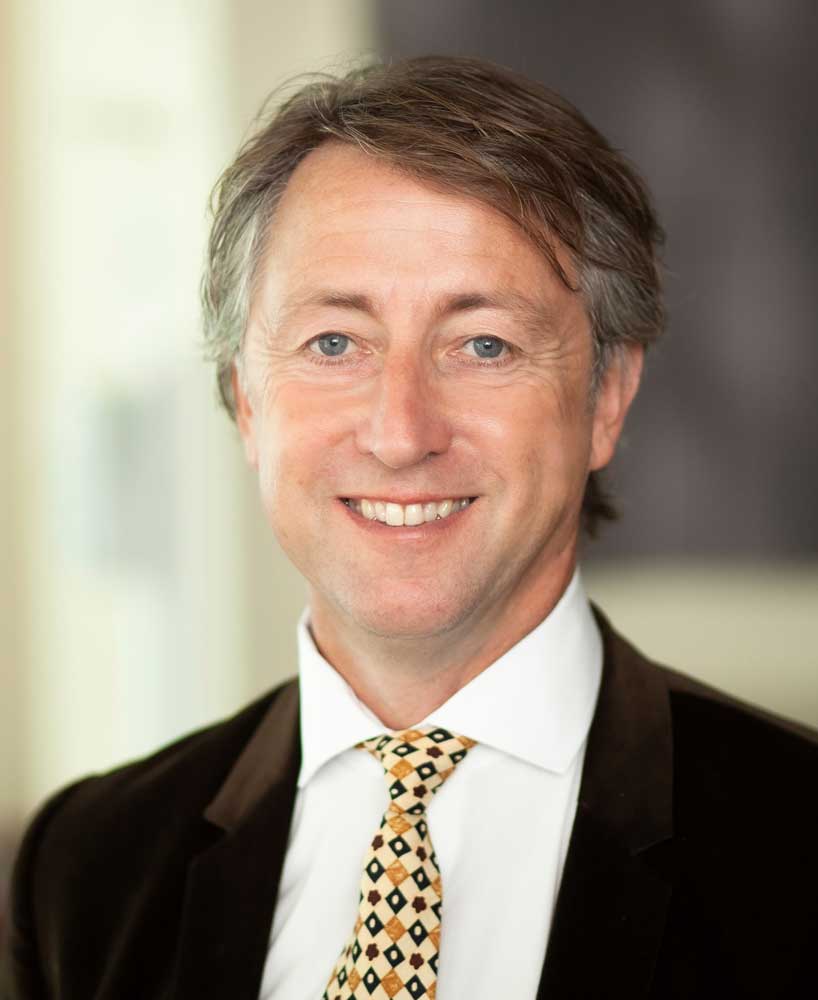
Dr Kieran Davis
Dean, Faculty of Pain Medicine
ANZCA
INTRODUCTION
Looking back twenty five years it is easy to see the foundation of the Faculty of Pain Medicine as inevitable, but what now seems inevitable involved vision and hard work by a dedicated group of future Specialist Pain Medicine Physicians. The fact that the FPM has fellows from multiple disciplines is again not by chance, but a decision made before the inception of the FPM and reflective of practice across Australia and New Zealand.
Pain Medicine in New Zealand and Australia began to grow in the early 1970s with the formation of clinics often based in shared offices in anaesthetic departments on borrowed FTE and predominantly based on the Seattle model of multidisciplinary care. This early belief, that pain medicine was best practiced using the knowledge and skills of physicians, psychiatrists, surgeons and anaesthetists working together led to the desire to found a faculty within ANZCA but including all specialists involved in pain medicine. Over time we have added to our list of recognised specialties, both within Australia and New Zealand and from countries around the world.
The driving force behind the formation of the FPM was Professor Michael Cousins; at that time he was at the Royal North Shore Hospital in Sydney although he had previously been at Flinders Hospital in Adelaide. After the Faculty of Anaesthesia RACS formed the Joint Advisory Committee in Pain Medicine in 1991 incorporating the five founding colleges, the direction had been set and the steady process to the formal founding of the FPM in October 1998 had begun.
If Professor Michael Cousins was the driving force in founding the FPM then Professor Milton Cohen has been the intellectual force behind the ethos that holds the FPM together. For 24 years as both the third dean and the Director of Professional Affairs he ensured our curriculum and training program had the necessary academic rigor as well as developing professional standards that are recognised around the world.
As the twelfth dean I can comfortably say that I am standing on the shoulders of giants; leaders in pain medicine who have created a medical specialty that still leads the world. The foundations of the FPM are sound, our training program was commended recently by the AMC/NCNZ, the Procedures Endorsement Program remains a unique model of training and our body of professional documents continues to grow and set the standards of pain medicine for New Zealand, Australia and the rest of the world.
Beginnings
“Looking back, what began as a quest for knowledge evolved into a journey into leadership.”
PROFESSOR
Michael Cousins
In an interview in 2017, Professor Michael Cousins explained how the Faculty of Pain Medicine came into being.
We went through a lot of interesting interactions between key people from the potentially cooperating specialties – so the five. And that eventually finished up as the Joint Advisory Committee on Pain Medicine.
It was difficult to get a cohesive approach from five different specialty areas. I was helped by the fact I knew the leadership of all those five bodies quite well. A key weapon I had was a comprehensive list of contact details in the front of my car. Every week I’d go at least one or two down the line, and then back and around again. I’d just keep talking to them about what we were doing. They were prepared to go along with it since this was a brand new specialty, and they wanted to be involved.
I gathered the people who were best suited to be representatives for their specialty at a dinner and asked them, “if all this goes ahead would you be prepared to be part of the body that emerges from this?” There was unanimous agreement.
The council meeting was not too far after that meeting. The president of the day, Richard Walsh, and a few other people, were already onside.
At that council meeting there were a number of objections. It was even suggested to put it aside and let the whole thing “mature a bit”. The president disagreed and decided council should thoroughly examine every bit of documentation. We went through every page, every line and, in the end, there were not really many objections.
You can watch the full interview with Professor Cousins below.
ASSOCIATE PROFESSOR
Leigh Atkinson
During the first seventy years of the twentieth century, neurosurgeons managed chronic pain and cancer pain with ablative surgical procedures including cordotomies, commisurotomies, rhizotomies and sympathectomies. The Boston neurosurgeon William Sweet published two influential textbooks on the subject, but the neurosurgeons withdrew during the nineteen seventies.
The research work of Patrick Walls and the practical patient care of Prof John Bonica at Washington State University in Seattle triggered significant changes to patient management.
John Bonica pioneered the concept and practise of a multidisciplinary approach with the understanding that patients with chronic pain had bio-psycho-social origins which require multidisciplinary treatments. His plan for the International Association for the Study of Pain combined international medical specialists and therapists and researchers.
Professor Michael Cousins had founded the department of Anaesthesia and Pain Management at Flinders University in 1975 with psychiatrist Prof Issy Pilowsky at the Royal Adelaide Hospital Pain Clinic.
In 1999, through the force of personality, and with his position on the board of the Australian and New Zealand College of Anaesthetists, he convinced the leadership of the Royal Australasian College of Surgeons, the Royal Australasian College of a Physicians and the Royal Australian and New Zealand College of Psychiatrists to unite to develop a new specialist training program called the Faculty of Pain Medicine under a training programme supervised by the ANZCA. This was launched in 2000 with Professor Michael Cousins as the founding dean, the second dean was a surgeon, the third a physician.
The first international multidisciplinary medical specialist training programme based on John Bonica’s concepts was established, and the specialty of pain medicine was established.
PROFESSOR
Pamela Macintyre
Michael Cousins was very keen to promote acute pain medicine as a key component of pain medicine in general and therefore a significant part of the FPM training curriculum. As an anaesthetist who practiced only in acute pain medicine, I was also appointed to the inaugural FPM Board.
At the time of the formation of the FPM, work was already underway for the first edition of Acute Pain Management Scientific Evidence (APMSE). This text with multidisciplinary contributors aimed to combine the best scientific evidence available at the time with current expert opinion. APMSE, now in its fifth edition (2020) and significantly larger given the exponential increase in evidence that occurred over the intervening 20 years, became widely read and respected internationally.
Endorsed by multiple national and international colleges and societies, it has resulted in ANZCA and FPM being seen as world leaders in acute pain medicine.
Late in 1999 the first ever FPM exams were held in Sydney at Royal North Shore Hospital. Acute pain medicine was a significant component of both the written and viva sections.
I’ve witnessed and been part of many changes over the years as the faculty sought to define both itself and the specialty. As the convenor for the 1999 annual scientific meeting, we were able to add two pain medicine sessions to the program for the first time. Now, faculty pain medicine days and workshops are included in the larger meeting program each year. The annual Spring Meeting, which began in 2007, provides another opportunity to gather and share knowledge and expertise.
DOCTOR
David Jones
Some of this work commenced even before the origin of ANZCA 1992, through its predecessor the Faculty of Anaesthetists, RACS. Prof. Michael Cousins during his 1988 Presidency of the IASP recommended that they develop formal training in pain management. In 1991 a small working party, later expanded and renamed Pain Management Advisory Committee, set out offering training towards a Certificate in Pain Management from June 1995. Certificate in Pain Management applicants underwent a demanding assessment, certainly no less than later cohorts of fellowship trainees and candidates. Once the faculty was established the 11 certificate holders were offered direct entry to the examination to complete summative requirements for award of fellowship.
At the time of commencing the certificate training only three units in Australia and one in New Zealand met accreditation criteria. A favourable outcome from having set eligibility criteria this early, even though few units met them, was that it incentivised other units to incorporate adequate multidisciplinary staffing in order to qualify. The effect of this was to lift the game as well as access when the number of units increased. Without those criteria the important contribution of clinical psychology as we now know it 25 years on would have taken a much slower path.
All applications for foundation fellowship and later those for election to fellowship came through the censor before submitting to board for approval. There was a more than 60cm high pile of CVs from the 98 applicants, from which 47 Foundation Fellows were approved.
Guiding principles that were laid down required the quest for even handed fairness in application of the criteria across multiple disciplines, aiming to not discourage applicants with backgrounds outside of anaesthesia. The intention was to be inclusive rather than exclusive. The latter principle became even more important in later years when applications for training were accepted from fellows of colleges other than the original five. A truly unique multidisciplinary body of fellows resulted.
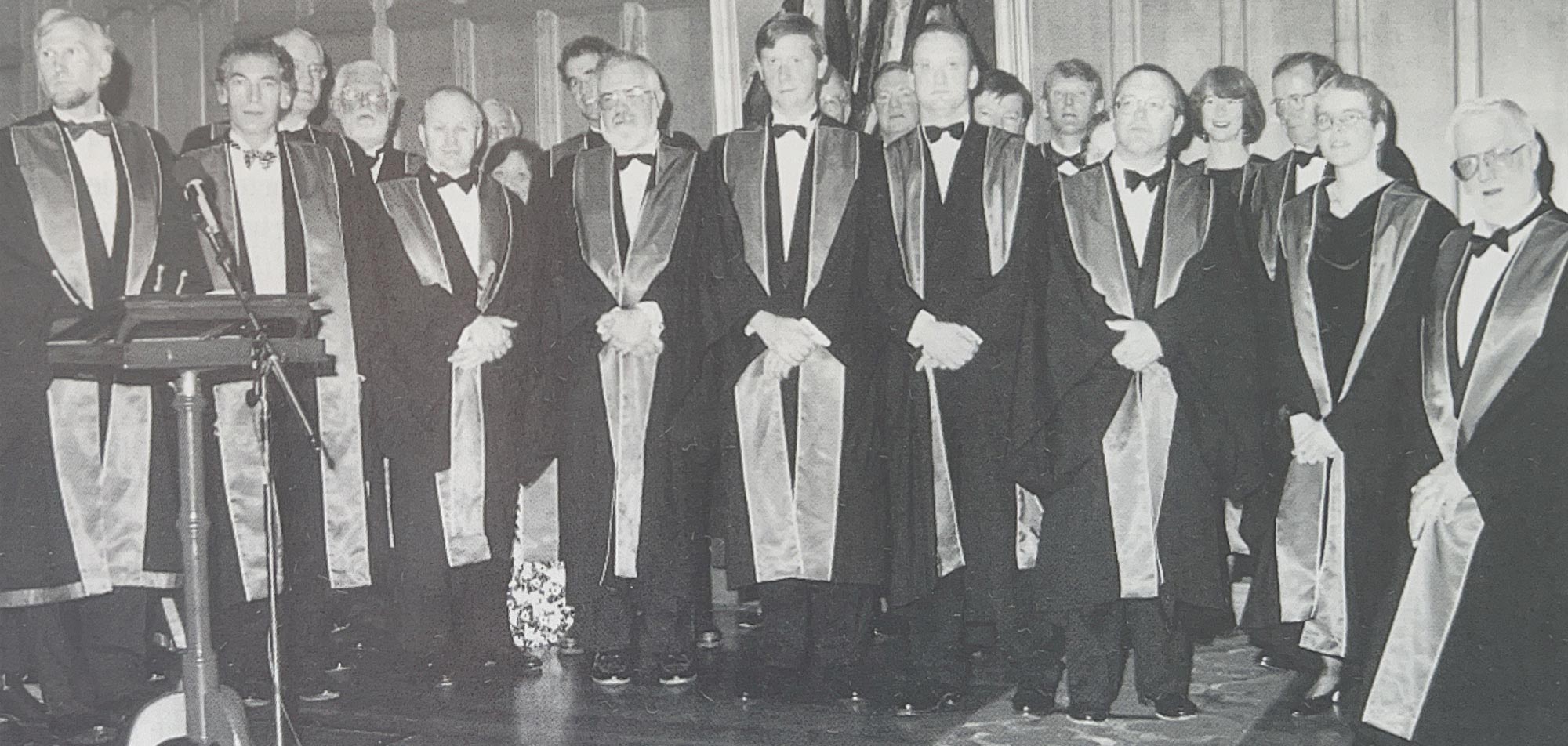
Foundation Fellows, c. 1999
Background image: Faculty of Pain Medicine Board, 1999. Back row: Dr Suellen walker; Professor John Gibbs, Dr Terry Little, Dr Graham Rice, Professor Milton Cohen, Professor Pam Macintyre, Professor Ben Marosszeky Front row: Dr David Jones, A/Prof Leigh Atkinson, Prof Michael Cousins, A/Prof Roger Goucke, Margaret Benjamin.
Defining the Specialty
“Everyone knows what “pain” is – until you try to define it.”
PROFESSOR
Milton Cohen
Everyone knows what “pain” is – until you try to define it. In 1998, when the faculty was formed as the first multidisciplinary medical academy in this area, it was both necessary to articulate the scope of this new discipline and challenging to define a “pain specialist”. The International Association for the Study of Pain (IASP) had produced curricula that tended to be neither patient-orientated nor user-friendly.
The faculty’s first “Objectives of Training” iteration reorganised material from the IASP curriculum into a biopsychosocial framework, presented under these headings:
- sociobiology of pain
- neurobiology of pain and nociception
- principles of pain medicine
- practice of pain medicine
The functions of the pain specialist, knowledge accumulation concerning “pain”, and advances in medical education evolved quickly. In 2012, a major review of the curriculum and training program addressed what knowledge and skills pain specialists uniquely bring to the health care community.
This process had three major aspects:
- altering the biopsychosocial paradigm to sociopsychobiomedical reorganisation according to the CanMEDS roles (clinician, professional, scholar, communicator, collaborator, manager/leader and health advocate)
- identification of nine essential topic areas where the specialty adds particular value:
- biomedical dimension of pain; acute pain; spinal pain; problematic substance use; visceral pain; cancer related pain; headache and orofacial pain; complex regional pain; and chronic widespread pain.
At this silver jubilee, while understandings of pain may remain diverse and elusive, the nature of pain medicine as a discipline and of the specialist pain medicine physician’s role in the broader healthcare system have been robustly established.
ASSOCIATE PROFESSOR
Carolyn Arnold
Establishing the Faculty of Pain Medicine reflected growing knowledge of pain as a disease entity. I was honoured to be a foundation fellow. As clinicians, teachers and researchers working in multidisciplinary fields of acute and chronic pain, we gave our time and enthusiasm to expand the knowledge. We did this by teaching, training, and advocacy.
In my work in Alfred Health, I approached leaders to support a model of pain care that was novel, and connected, in order to train future pain medicine physicians. I wanted to achieve this goal, to advocate for the “new specialty”, amongst more traditional models of acute hospital services. By chance I met the CEO in an elevator and made a pitch. He listened and then wisely advised of the difficulties, as everyone sees pain management as a black hole for money! So, I experienced many knockbacks, and quickly learnt the importance of data and research, and costs of services.
My own projects included establishing the bi-national chronic pain outcome registry, ePPOC. Working with Chris Hayes, and consulting widely, this was formally established in 2013. I also made contributions as a faculty board member, examiner, chair of various committees, and as a conference convenor. I participated in clinical research, guided by mentors. I enjoyed teaching and sharing knowledge.
Looking back, what began as a quest for knowledge evolved into a journey into leadership.
Looking forward, I hope we can mentor our fellows to take the steps to leadership – for the future of pain medicine, for the satisfaction, and importantly – for our patients, who really deserve our skilled, knowledgeable care.
ASSOCIATE PROFESSOR
Greta Palmer
Defining the pain medicine specialty in Australia and New Zealand is a journey of two and a half decades.
In 1999, the first FPM fellowships were awarded to 47 specialists for their longstanding contribution to patient care. Although election to fellowship was maintained until recently, most subsequent admission has been by examination. I gained my FPM fellowship as part of the second cohort sitting the 2000 exam, while doing pain medicine training in the USA. At that time, the FPM curriculum and Acute Pain Management Scientific Evidence (APMSE) were slim A4 booklets, with the FPM clinical training program in its infancy.
I returned to Australia in 2001 to work in paediatric pain management, then an emerging subspecialty.
I’m very proud to have become an active contributor to the faculty on multiple projects, including as a supervisor of pain training, a faculty examiner and deputy chair, a case study co-ordinator, developing training processes and tools such as long case assessment guidelines, and working on the APMSE.
The APMSE project has been a defining activity of the faculty and its members. It is exemplary in demonstrating the combined dedication and hard work of the editorial committee and contributors who devote their personal time to search and review literature, producing a quality document now published in two volumes. This book is internationally recognised and a credit to the profession. Its part in defining the specialty is its emphasis upon using evidence base in (acute) pain management practice along with highlighting what is still unknown and requiring further study.
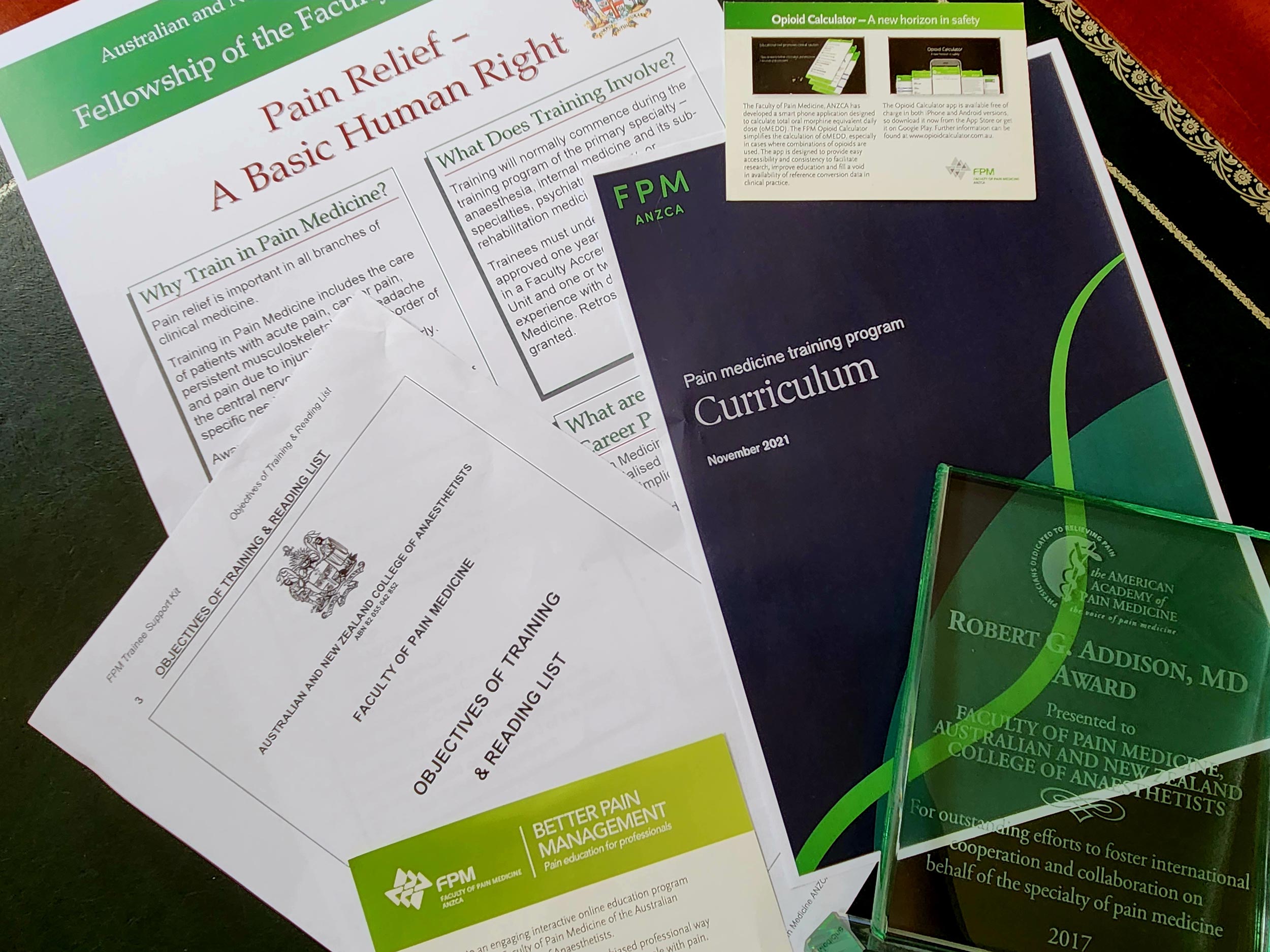
Impact and Influence
“Fellowship surveys have always supported loud and effective advocacy for those in pain as a fundamental value for FPM.”
DOCTOR
Tipu Aamir
Aotearoa New Zealand has a long history of offering interdisciplinary care for mamaenga roa – chronic pain. The first pain clinic was established in Auckland in 1974/75. The clinics were developed by physicians interested in treating mamaenga roa chronic pain without a centralised government plan.
Treatment of mamaenga roa chronic pain was not recognised as a priority by Manatū Hauora, Ministry of Health. In 2012 pain medicine became a vocational speciality recognised by the Medical Council of New Zealand and the New Zealand national committee started to work on an advocacy plan. In 2018 the Faculty of Pain Medicine commissioned the Sapere report, which looked at mamaenga roa chronic pain and improving patient outcomes in Aotearoa New Zealand.
The national committee advocated for recognising mamaenga roa chronic pain as a leading health problem and the need to improve equity of service provision across the country. In 2021 the Manatū Hauora Ministry of Health set up a multidisciplinary advisory group to design a model of care framework. The group included pain medicine specialists, psychologists, nurses, educators, general practitioners, Pasifika and Māori, physiotherapists, consumers, and the Accident Compensation Corporation.
The resulting model of care is based on the concept of Te Whare Tapa Whā – the four cornerstones (or sides) of Hauora Māori. These cornerstones are Taha tinana (physical health), Taha wairua (spiritual health), Taha whānau (family health) and Taha hinengaro (mental health). The model emphasises the need to commit to fulfilling the special relationship between Māori and the Crown specified under Te Tiriti ō Waitangi (Te Tiriti).
The model of care recommends interdisciplinary teams offer mamaenga roa chronic pain treatment. There need to be equitable pathways of care. A broader sociopsychobiomedical approach should be grounded by Te Whare Tapa Whā model. Local and specialist teams and peer support networks should be utilised.
This is a big win; however, further work needs to be done so the guiding principles in this model are accepted by newly formed agencies (Te Whatu Ora and Te Aka Whai Ora (the Māori Health Authority)) responsible for improving services and outcomes across the health system.
DOCTOR
Leinani Aiono Le Tagaloa
“Sole sole ia e loto tele!
O le taaloga faatamatane
E ui lava ina tiga tele
Ae mulumuli ane ua e fefete!”
These words are part of a song that celebrates the tatau; the ceremonial tattooing of Samoan men, the rite of passage into manhood. The songwriter notes the rhythm of the instruments and the young man’s cries of pain, and then urges courage and silence, because to do so will bring honour for him and his family.
It’s not only Samoans who bear pain in silence. Studies suggest Indigenous people exhibit less observable pain behaviours, and reluctance to discuss the origin of their pain. The cultural and social environment informs this. It differentiates between culturally appropriate silence and the lack of a voice to communicate pain, to validate it, to tell of its magnitude or its impact.
Pain can result in severe physical disability, emotional and social suffering, depression, unemployment, low self-worth, and social isolation. Lower socioeconomic status and poor access to effective pain management increase Indigenous communities’ risk of living with chronic painful conditions, highlighting the need to evaluate and treat pain in this vulnerable group.
There are limited studies informing concepts of pain, pain assessment and pain relief among Indigenous people; much of the literature is from studies conducted largely on Caucasian populations. Recently, the lack of pain assessment tools specifically developed for capturing Māori experiences of pain in Aotearoa New Zealand has also been highlighted. Culturally competent research needs to be carried out in partnership with Indigenous communities, to give voice to their pain and inform the development of effective and acceptable pain management strategies and programs.
A framework for this can be found in the three core pillars outlined in the 2016 State of Reconciliation in Australia report – relationships, respect, and opportunities. Underpinning these is the acknowledgement of the dignity and value of all people, and respect for their cultures and way of life. In 2023 ANZCA and FPM launched their Innovate Reconciliation Action Plan, addressing inequities in health outcomes. It is a fitting milestone as we celebrate 25 years since the Faculty of Pain Medicine was founded.
The young Samoan man of the song will flaunt his tattoo with pride, having endured his pain in silence. Our hope is that Indigenous communities in pain will trust us and break their silence, and partner with us in the solution.
ASSOCIATE PROFESSOR
Michael Vagg
Public advocacy for those with pain is part of the DNA of FPM. Its founders had a passion and drive to improve the situation of their patients, and those in pain who they would never meet. Establishing a medical specialty body that could lead the way in education and training of health professionals was the first step to advance this mission. This was followed by our international leadership in the process which led to the Declaration of Montreal in 2010 which challenged world governments to treat access to pain care as a human right for their citizens. In recent years, FPM has become increasingly engaged with bureaucratic decision makers to help develop strategic plans and models of care, including the National Strategic Action Plan for Pain Management in Australia and the development of a new national model of care in Aotearoa New Zealand.
Our leadership in education for health professionals has been highlighted by the Better Pain Management modules, providing online education for tens of thousands of GPs, allied health and nursing professionals (including students) for more than a decade. More recently, the faculty was commissioned by the Australian Government to write a report outlining requirements for health practitioner education in pain, a piece of work which has led on to a further commission to develop standards for education in all disciplines.
Fellowship surveys have always supported loud and effective advocacy for those in pain as a fundamental value for FPM. Influence is a long-term undertaking that requires trust and patience over a period of time, but we are gaining ground every year!
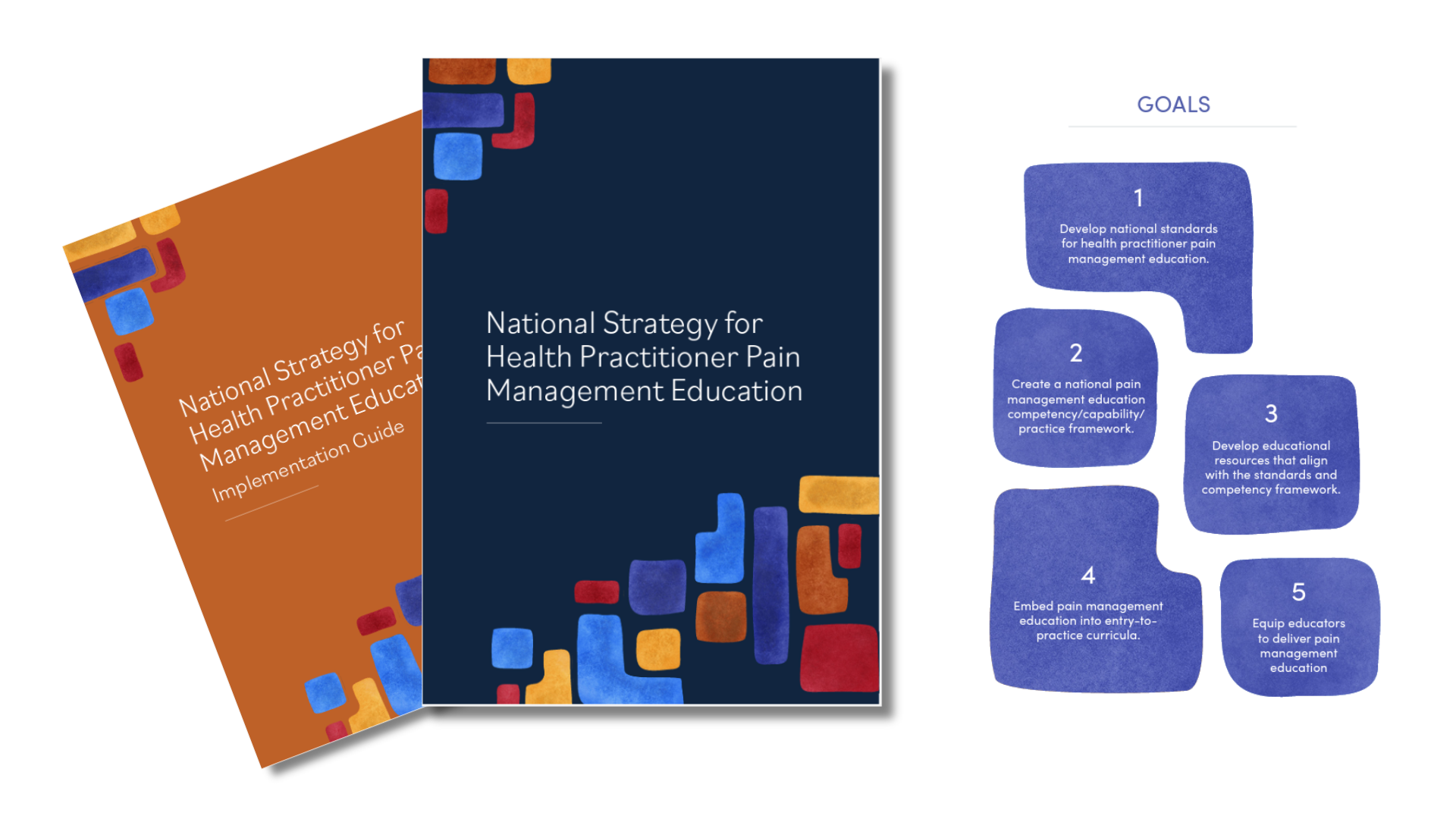
The Future
“It is imperative that we embrace diversity so our trainees can benefit and learn from the fellows’ valuable clinical expertise.”
DOCTOR
Amrita Prasad
The Faculty of Pain Medicine has grown and evolved over the years. Exciting and innovative times lie ahead.
The faculty recognises the diversity of practice of pain medicine physicians who have already obtained their primary specialties. Future trainees may be able to obtain direct entry into the pain medicine program, making it a primary fellowship. This potentially means significant increase in the number of trainees.
The faculty strongly endorses gender equity and I’m excited about the growth of women physicians in our specialty, particularly in leadership positions and as speakers. I commenced an exciting chapter in 2023 in my role as the New Fellow Representative on the faculty board and I look forward to making a valuable contribution.
A big milestone in 2021 was the commencement of the Procedure Endorsement Program. I’m honoured and privileged to be the first woman endorsee. Each year more trainees are signing up for endorsement, and in the next 25 years most, if not all, physicians will be endorsed.
The future will also bring new indications for current technologies and new advanced technologies in the management of chronic pain patients. Developments in artificial intelligence will be exciting, but this will not replace the human connection that is integral to the management of pain patients.
As the Faculty of Pain Medicine evolves, so do we, and it is our responsibility to work together to guide its direction, so in another 25 years we can look back and once again be proud of all that we’ve achieved.
DOCTOR
Nitin Yogesh
The FPM has come a long way from starting the world’s first pain medicine training program to now contemplating pain medicine as the primary specialty for future doctors. The vision to do so emerged largely from two factors: recognising our fellowship’s growing diversity and making pain medicine more accessible and appealing to the medical fraternity.
Recently, there has been a rise in the number of new trainees and fellows from non-anaesthetic backgrounds, which adds to the fellowship’s diversity and extensive clinical experience. Some fellows, including myself, have transitioned from practising their primary speciality to full-time pain medicine practice. The expertise, skills, and knowledge of the primary speciality greatly assists in better pain medicine practice. My journey from a full-time neurosurgeon overseas to full-time SPMP in Australia was quite challenging yet rewarding. Currently, as the director of a Level 1 training unit, I believe it is imperative that we embrace this diversity so our trainees can benefit and learn from the fellows’ valuable clinical expertise.
Pain medicine is continually and rapidly evolving, with new discoveries and therapies being published, and simultaneously contested, which at times makes it difficult to decide on the appropriate evidence-based treatment. We will need more SPMPs in the future, not only as clinicians but also as researchers. Pain medicine should be available to medical graduates who desire to pursue it as their sole speciality. Our growing fellowship may require a distinct speciality college in the future, and an entirely new training program. The next phase of pain medicine is both exciting and challenging, but only through inclusivity, collaboration, and, particularly, learning from each other, will we be able to progress.
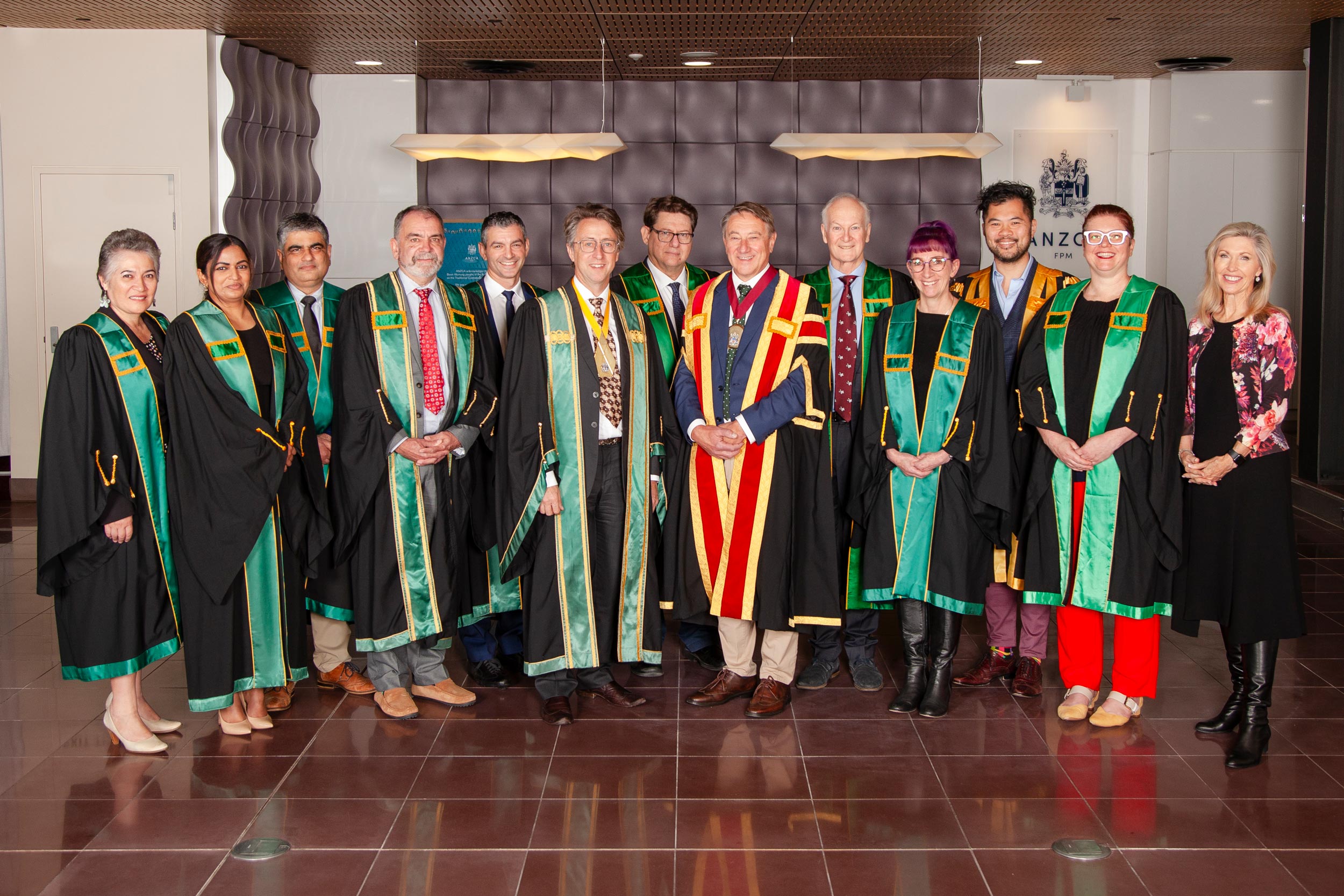
2023 Faculty of Pain Medicine Board: (left to right) Satualafaalagilagi Dr Leinani Salamasina Aiono-Le Tagaloa, Dr Amrita Prasad (New fellow), Dr Tipu Aamir, Dr Dilip Kapur (FPM Vice-Dean), Dr Noam Winter, Dr Kieran Davis (FPM Dean), Prof Michael Veltman, Dr Chris Cokis (ANZCA President), Dr Murray Taverner, Dr Susie Lord, Dr Scott Ma (ANZCA Councillor), Dr Amanda Wisely, Ms Leone English (Executive Director, FPM).
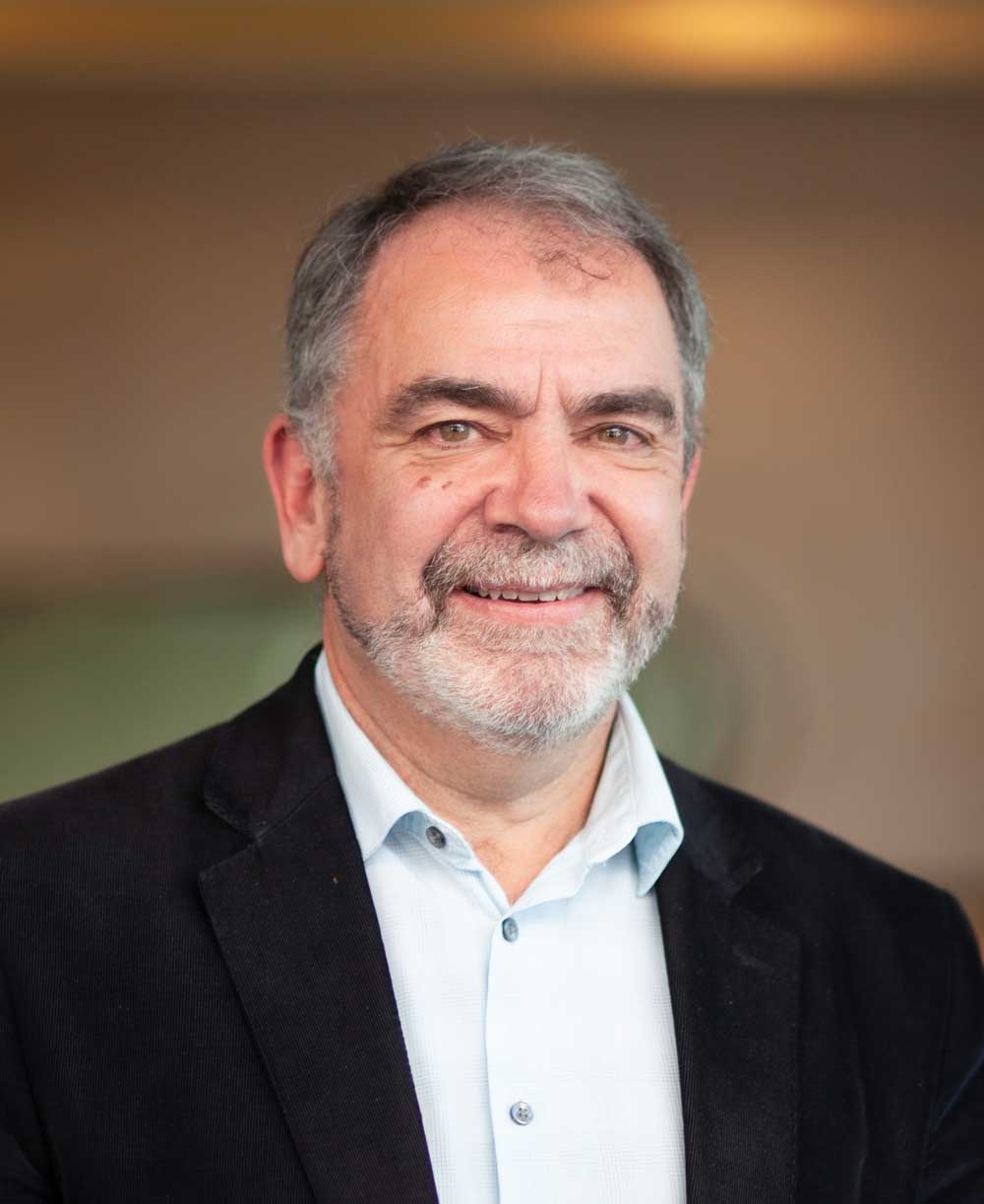
Dr Dilip Kapur
Vice Dean, Faculty of Pain Medicine
ANZCA
DOCTOR
Dilip Kapur
The achievements of The Faculty of Pain Medicine and its fellows through the past quarter-century are impressive in any context. We have a vibrant and active fellowship, well engaged in the faculty’s development. As a proportion of its fellowship, the faculty has far greater numbers participating in key processes of education, monitoring and development than most other colleges. This bodes well for our future.
The key doctrine that supported the founding of the faculty was the understanding that patients burdened with complex pain could not be assisted through a simplistic process of symptom support through to resolution of disease. The interacting effects of sociological, psychological and biological factors are familiar to all who have completed training as specialist pain medicine physicians. Retaining a focus on these elements will be essential if we are to maintain the status we have earned as skilled and thoughtful clinicians.
We have many opportunities to improve our profile amongst the patients that we serve. Access to, and funding for, treatment are perennial problems. But maintaining excellence in education, training and clinical practice will always bear fruit. At the time of the faculty’s inception, facilities for effective pain management were far inferior to their current state.
The welfare of our fellowship must be a priority. Pain medicine can be a tough and demanding area in which to practice. Our core skills place us in a good position to care for each other. This can be a doubly productive enterprise. Healthy doctors deliver good care. Our patients deserve nothing less.
DEANS OF THE FACULTY
Professor Michael Cousins, AO
1999 – 2002
Associate Professor Leigh Atkinson, AO
2002 – 2004
Professor Milton Cohen AM
2004 – 2006
Doctor Roger Goucke AM
2006 – 2008
Doctor Penny Briscoe, AM
2008 – 2010
Doctor David Jones
2010 – 2012
Associate Professor Brendan Moore
2012 – 2014
Professor Ted Shipton
2014 – 2016
Doctor Chris Hayes
2016 – 2018
Associate Professor Meredith Craigie
2018 – 2020
Associate Professor Michael Vagg
2020 – 2022
Doctor Kieran Davis, 2022 –
FOUNDATION FELLOWS
Rupert Leigh Atkinson
Milton Laurence Cohen
Michael John Cousins
Charles Roger Goucke
David Jones
Terence Francis Little
Pamela Elizabeth Macintyre
Jeno Emil Marosszeky
Graham Inglis Rice
Suellen Monica Walker
Carolyn Arnold
Thomas John Berrigan
Geoffrey Charles Booth
James Palmer Bradley
Penelope Anne Briscoe
Charles David Brooker
Michael James Butler
Robyn Majella Campbell
Mary Suma Cardosa
Geoffrey David Champion
David Alan Cherry
Teresa Rita O’Rourke Cramond
Matthew Ronald Crawford
John Norman Ditton
Paul James Graziotti
David William Gronow
Newman Leon Harris
Christopher Hayes
Edward William Hughes
Kok Eng Khor
Bruce McNeill Kinloch
George Mendelson
Allan Richard Molloy
Andrew David Muir
Frank James New
James Patrick O’Callaghan
Edward Glyndwr Richards
Lindy Jane Roberts
Bruce Frederick Rounsefell
Daryl Mackinnon Salmon
Stephan Alexander Schug
Timothy James Semple
Gilbert Barrie Wharton Tait
Richard John Vaughan
Peter Robert Wilson
Robert Darrel Helme
Peter John Ravenscroft
This website and the accompanying booklet have been created to document the 25th Anniversary of the FPM in conjunction with ANZCA’s Geoffrey Kaye Museum.
